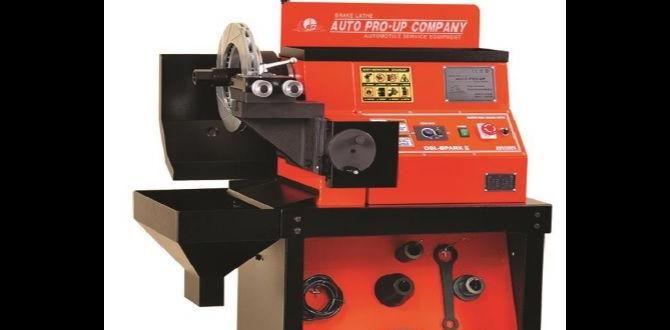Quick Summary: For rapid material removal in tool steel, a carbide end mill is essential. A 1/8-inch diameter with a 1/4-inch shank and standard length is a versatile choice. Using the right carbide end mill ensures high MRR, efficiency, and a clean finish on tough materials like A2 steel.
Working with tough materials like tool steel on your milling machine can feel like wrestling a bear. You have a project in mind, but the idea of cutting through hardened steel makes you hesitate. It’s a common worry for many beginners diving into metal machining. You want that precise cut, that efficient material removal, without dulling your tools instantly or risking a broken end mill. Many find it frustrating when their milling efforts don’t go as smoothly as hoped. But what if there was a secret weapon to make this process not just manageable, but surprisingly efficient? The answer lies in choosing the right tool, specifically, a carbide end mill. This guide is here to show you exactly why and how a carbide end mill is your best friend for tackling tool steel, paving the way for high material removal rates (MRR) and successful projects. Let’s get your milling game on track!
Understanding Tool Steel and the Need for Speed
Tool steel is a marvel of metallurgical engineering. Designed for extreme hardness, wear resistance, and toughness, it’s the material of choice for creating dies, punches, cutting tools, and molds. Think of the sharp edge on a high-quality knife or the durable components in manufacturing equipment – that’s often tool steel at work. However, these desirable properties make it notoriously difficult to machine. Traditional High-Speed Steel (HSS) cutters can struggle, leading to slow progress, excessive heat buildup, and premature tool wear. This is where the concept of Metal Removal Rate (MRR) becomes crucial. MRR is simply the volume of material you can remove per unit of time. Higher MRR means faster machining, which translates to saved time and lower costs, especially in production environments. For achieving high MRR in demanding materials like tool steel, you need a tool that can withstand the abuse and cut aggressively. This is precisely where carbide end mills shine.
Why Carbide is King for Tough Materials
The magic of carbide end mills lies in their material composition. Unlike HSS, which is primarily iron-based, carbide end mills are made from tungsten carbide, a composite material that is five to ten times harder and significantly stiffer than steel. This extreme hardness doesn’t come at the expense of toughness, either; carbide offers excellent resistance to chipping and fracture when properly applied.
Here’s why carbide is your go-to for tool steel:
- Superior Hardness: Carbide maintains its cutting edge much longer than HSS at higher temperatures. Tool steel generates significant heat during machining, and HSS can soften, losing its effectiveness. Carbide stays sharp.
- High Rigidity: Carbide is much stiffer than steel. This means it deflects less under cutting forces. Less deflection leads to more accurate parts and reduces the risk of the cutter rubbing against the workpiece, which can cause tool breakage.
- Heat Resistance: The ability to withstand higher temperatures means you can often run carbide end mills at faster cutting speeds and feeds, directly contributing to a higher MRR.
- Wear Resistance: The extreme hardness also translates to excellent wear resistance, meaning your end mill will last longer, even when cutting abrasive materials.
While carbide cutters are more brittle than HSS and require a more rigid machine setup and precise machining parameters, their performance benefits when machining tool steels far outweigh these considerations. For beginners, this means choosing the right carbide end mill and setting it up a bit more carefully will yield dramatically better results than struggling with HSS.
Choosing the Right Carbide End Mill: Key Specifications
When you look at carbide end mills, especially those designed for tool steel and high MRR, a few key specifications will jump out. For newcomers, these can seem a bit daunting, but understanding them is vital for success. We’ll focus on a common and versatile configuration: a 1/8-inch diameter with a 1/4-inch shank and standard length.
Diameter: The 1/8-Inch Sweet Spot
The diameter of an end mill is its cutting width. A 1/8-inch (0.125 inches or 3.175 mm) diameter end mill is a fantastic choice for general-purpose machining on smaller to medium-sized projects where precision is important. It’s small enough to get into tighter areas and perform intricate detailing, yet robust enough for some decent material removal when paired with appropriate speeds and feeds. For tool steels, this size allows for manageable cutting forces.
Shank Diameter: The 1/4-Inch Standard
The shank is the part of the end mill that fits into your milling machine’s collet or tool holder. A 1/4-inch (0.25 inches or 6.35 mm) shank is a very common size. It offers a good balance of rigidity and compatibility with a wide range of milling machine setups. While larger shanks can offer increased rigidity, a 1/4-inch shank is standard for many entry-level and hobbyist machines and provides sufficient holding power for 1/8-inch end mills when used correctly.
Length: Standard vs. Extended
End mills come in various lengths. A “standard” length end mill generally means it’s not excessively long or short. For a 1/8-inch diameter tool, a standard length would typically allow for a decent depth of cut without becoming overly flexible. Extended length tools are longer, allowing for deeper reach but are also less rigid and more prone to vibration. For machining tool steel and aiming for high MRR, a standard length is usually preferred for its rigidity. Extended reach is generally not the priority when blasting through hard materials.
Flute Count: How Many Teeth Are Best?
The “flutes” are the helical grooves that run along the cutting edge of the end mill. These flutes carry away chips and contribute to the cutting action. For machining metals, especially tougher ones like tool steel, the flute count matters:
- 2 Flutes: Generally preferred for milling softer materials or when chip evacuation is a primary concern. They offer more space between flutes for chips. For tool steel, this can be a good option if you’re prioritizing chip clearance and are using high-pressure coolant.
- 3 Flutes: A good compromise. They offer better rigidity than 2-flute end mills and can handle faster feed rates. They are excellent for general-purpose milling in steels and other metals.
- 4 Flutes: The most rigid option. They provide the best stability and are ideal for harder materials like tool steel, especially when slotting or shoulder milling, as they allow for higher feed rates thanks to their rigidity. When aiming for high MRR in tool steel, 4-flute carbide end mills are often the top choice.
For tool steel MRR, a 4-flute carbide end mill is typically the most effective choice due to its rigidity, allowing it to handle aggressive cuts without excessive chatter or deflection. If chip evacuation becomes an issue, you might switch to a 2-flute, but start with 4-flutes if possible.
Coating: The Extra Edge
Many high-performance carbide end mills come with coatings. These thin layers of a hard material applied to the surface of the end mill provide several benefits:
- Increased Hardness: Further enhances wear resistance.
- Reduced Friction: Helps prevent chips from welding to the cutting edge (buildup).
- Improved Heat Resistance: Some coatings can help deflect heat away from the cutting edge.
Common coatings for machining steel include:
- TiN (Titanium Nitride): A golden-colored coating offering good general-purpose hardness and wear resistance. A good entry-level coating for tool steel.
- TiCN (Titanium Carbonitride): Denser than TiN, it offers even better wear resistance and is good for abrasive materials. It has a grayish, purplish hue.
- AlTiN (Aluminum Titanium Nitride): Excellent for high-temperature applications and machining stainless steels and hard steels. It forms a protective aluminum oxide layer at high temperatures, providing superior heat resistance and extended tool life. This is often the top choice for machining tool steels aggressively.
For tool steel MRR, an AlTiN coating is highly recommended.
End Type: Flat, Ball, or Corner Radius?
The shape of the end of the end mill determines the profile of the cut:
- Flat End Mills: Create square shoulders and flat-bottomed slots. They are the most common type and versatile for general machining.
- Ball End Mills: Have a hemispherical tip, used for creating rounded profiles, 3D contours, and fully radiused slots.
- Corner Radius End Mills: Have a small radius on the corners. This adds strength to the corners, reduces stress concentrations, and helps create a small fillet at the bottom of a shoulder, preventing stress risers. For machining hardened tool steels, a corner radius is highly beneficial as it strengthens the end mill’s corner. It’s common to see tools designed for tool steel with a small corner radius, even if it’s just 0.010” or 0.020”.
For general aggressive material removal in tool steel, a flat end mill with a small corner radius is often ideal. This provides the corner strength needed to resist chipping while maintaining the ability to mill flat surfaces and shoulders.
Setting Up for Success: Machine and Workpiece Rigidity
Carbide end mills, especially smaller ones like 1/8-inch, demand a rigid setup. This is non-negotiable when working with tool steels. A flimsy machine, loose workpiece fixturing, or a wobbly tool holder will lead to chatter, poor surface finish, tool breakage, and significantly reduced MRR. For beginners, this means:
Machine Rigidity: Your milling machine should be solid and well-maintained. Ensure there’s no excessive play in the ways, spindle bearings are good, and the machine itself is heavy enough to absorb cutting forces. Smaller benchtop mills might struggle with aggressive cuts in tool steel. Look for machines with features designed for rigidity, and keep them clean and lubricated.
Workpiece Fixturing: The material you are cutting (the workpiece) must be clamped down securely. Use sturdy vises, clamps, or specialized fixturing. Ensure the workpiece is sitting flat and is not cantilevered excessively. Any movement of the workpiece during the cut is asking for trouble.
Tool Holder Rigidity: Use a high-quality tool holder, such as a hydraulic chuck or a precision collet chuck, that provides excellent runout and clamping force. Avoid older, less precise collet systems if possible, and always ensure your collet and nut are clean and properly seated. Runout (the amount the tool deviates from spinning perfectly true) should be minimized.
Speeds and Feeds: The Heart of MRR
This is where the magic happens, but it can also be where beginners get overwhelmed. Speeds and feeds are critical for any milling operation, but especially for maximizing MRR in tool steel with carbide.
Surface Speed (SFM/SMM)
Surface speed refers to the rate at which the cutting edge of the end mill is moving across the surface of the workpiece. This is usually expressed in Surface Feet per Minute (SFM) or Surface Meters per Minute (SMM). Carbide end mills can run much faster than HSS. For various carbide grades and coatings machining tool steel, you might find recommended surface speeds ranging from 150 to 500 SFM (45 to 150 SMM), but it always pays to check the manufacturer’s recommendations.
The relationship between surface speed, spindle RPM, and tool diameter is:
RPM = (SFM 12) / πD
Where:
- RPM = Spindle Revolutions Per Minute
- SFM = Surface Feet per Minute
- 12 = inches in a foot
- π (Pi) ≈ 3.14159
- D = Tool Diameter in inches
For example, if you want to run at 300 SFM with your 1/8″ (0.125″) end mill:
RPM = (300 12) / (3.14159 0.125) ≈ 9167 RPM
This is a high RPM, which is why rigid spindles and machines are key. For many hobbyist machines, you might be limited in RPM. In such cases, you’ll need to adjust your feed rate down to compensate.
Feed Rate (IPM/MM/min)
Feed rate is how fast you advance the tool into the material, usually measured in Inches per Minute (IPM) or Millimeters per Minute (MM/min). This directly impacts MRR and chip load.
Chip Load: This is the thickness of the chip being removed by each cutting edge (or flute). It’s crucial for good machining. Too small a chip load, and you’re rubbing, not cutting, generating heat and dulling the tool. Too large, and you risk overloading the tool or machine, leading to breakage.
The chip load is determined by:
Chip Load = Feed Rate / (RPM Number of Flutes)
For carbide machining steel, a chip load might range from 0.001″ to 0.005″ (0.025 mm to 0.127 mm) for a 1/8″ end mill, depending on the specific carbide grade, coating, and machine rigidity. Always start conservatively and increase as you gain confidence and observe the cutting action.
So, to find your target Feed Rate:
Feed Rate = RPM Number of Flutes Chip Load
Using our example with 300 SFM (9167 RPM), 4 flutes, and a target chip load of 0.003″:
Feed Rate = 9167 RPM 4 0.003" ≈ 110 IPM
Depth of Cut (DOC) and Width of Cut (WOC)
These parameters determine how much material is removed in a single pass. Achieving high MRR often means taking advantage of maximum allowable DOC and WOC, but this requires a rigid setup and appropriate speeds/feeds.
- Depth of Cut (DOC): How deep the end mill cuts into the material vertically. For a 1/8″ end mill, a typical radial DOC might be 0.010″ to 0.050″ (0.25 mm to 1.27 mm). The axial DOC (how deep the tool goes into the material to create a slot) can be higher, but for tool steel, you’ll likely want to be conservative, perhaps starting with 0.1x to 0.2x the tool diameter.
- Width of Cut (WOC): How much of the end mill’s diameter is engaged in the material horizontally. Full width (100%) is used for slotting. For shoulder milling (creating a flat wall), a radial engagement of 50% is common, but modern high-efficiency milling (HEM) strategies can use much higher radial WOCs (up to 90%) when conditions are right.
Rule of Thumb for Tool Steel: For tool steels, especially with carbide, it’s often better to take lighter axial depths of cut and full or maximum reasonable widths of cut, compared to trying to hog out material very deep in one pass. However, the goal is to push closer to the tool’s limits to maximize MRR without compromising tool life or surface finish.
Material Type Considerations (Example: A2 Tool Steel)
A2 tool steel is a popular air-hardening medium-alloy tool steel known for its good combination of toughness, wear resistance, and hardenability. Machining A2 tool steel requires care. It is typically machined in its annealed state, which is softer, but it still presents significant challenges compared to mild steel or aluminum. If you are machining A2 tool steel that has already been hardened, the requirements become much more stringent, often requiring specialized tools and extremely slow material removal rates.
When machining annealed A2, you can generally use the speeds and feeds discussed above for tool steels. Always consult the specific carbide end mill manufacturer’s recommendations and your machine’s capabilities. A good starting point for annealed A2 with a 1/8″ AlTiN coated carbide end mill might be:
- SFM: 250-350
- RPM (for 1/8″ tool): ~7,600 – 10,600 RPM
- Chip Load: 0.002″ – 0.004″
- Feed Rate: ~76 IPM – 170 IPM (based on RPM and chip load)
- Axial DOC (for slotting): 0.050″ – 0.100″
- Radial DOC (for shoulder milling): 0.040







